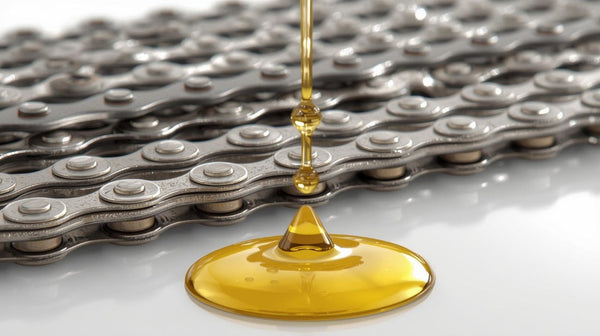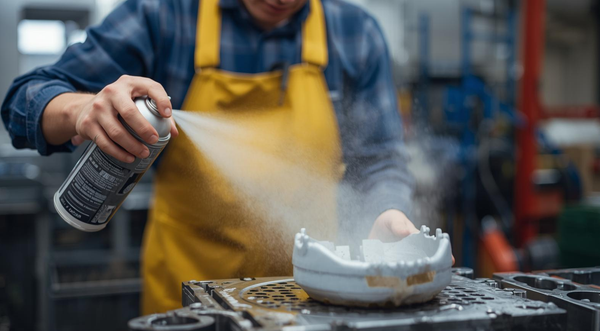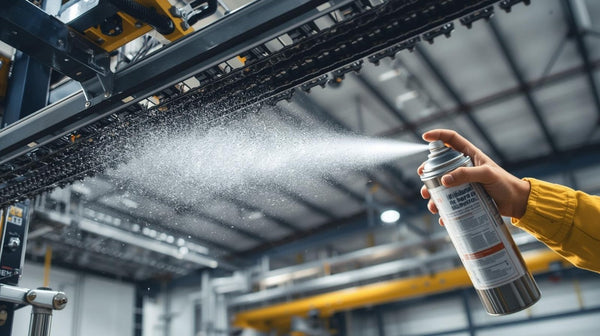What grease for high temperatures

What grease to choose for high temperatures – this is a question that every technologist faces when high temperatures occur in his process.
For our purposes, we'll define it briefly and "old-fashioned": a "high-temperature grease" is one that can operate continuously above approximately 150°C . Below this threshold, we're more likely to talk about standard or "elevated temperature" greases. Since the devil is in the details, here's a handy cheat sheet:
Approximate temperature thresholds
- up to 100–120 °C – standard greases (usually lithium).
- 120–150 °C – “high temperature” (better lithium/complex, sometimes polyurea).
- 150–200 °C – high-temperature (lithium-complex, calcium-sulfonate, polyurea, often based on synthetic oils).
- 200–260 °C – very high temperature (PFPE/PTFE, some silicone; shorter intervals, specific applications).
- >260 °C – this is the land of solid lubricating pastes, dry coatings (graphite, MoS₂) or specialized PFPE greases; classic lubrication can be short-lived.
To sum up : for our purposes, when asked what grease is suitable for high temperatures, we answer: "high temperature" sensibly starts at ~150 °C (continuous operation) .
In traditional maintenance, the adjective "high-temperature" isn't a decorative label, but a commitment. A grease is supposed to maintain a lubricating film and rheology where conventional systems have long since oxidized, evaporated, and "chalked." So before we reach for the tube "up to 300°C" with its garish font, let's establish the facts: what degrades greases in heat , which chemical families we use , which TDS parameters are crucial , and how to select a grease for a specific function (bearing, slide, chain, thread). Below – a technical, conservative approach to this topic.
What does grease measure up to at high temperatures?
Degradation mechanisms:
- Thermo-oxidation of the oil base: rapid increase in the reaction rate → varnishes and coke, increase in viscosity, loss of film mobility.
- Evaporation of light fractions : the thickener matrix is "dried out", the film becomes thinner, the boundary friction increases.
- Thickener aging : softening (soup) or hardening (chalk) upon shearing/heating → change in penetration and pumpability.
- Loss of AW/EP additives and antioxidants : once they are depleted, degradation accelerates exponentially.
- Water/steam/dust : corrosion catalysis, abrasion, film quality degradation.
The above list allows us to assume the rule that: "high temperature" should be assessed in continuous operation temperature and time , and not in "peaks".
Grease Families for Warm Applications – What, Where and Why
1. Base oils (they really lubricate)
- PAO / synthetic esters – low evaporation loss, good oxidation resistance; feasible continuous operation up to ~180–220 °C (depending on formulation).
- PFPE (perfluoropolyethers) – the league of extremes: very low volatility , chemical inertness, clean degradation (no tar formation); continuous operation 220–260 °C+ . First choice when downtime is expensive or perfect cleanliness is required (paint shops, food processing).
- Silicones (PDMS/phenylsilicones) – excellent water and T resistance, but lower metal-to-metal film load capacity ; great for EPDM/electrical connectors/fittings , careful in high-speed bearings.
2. Thickeners (oil carrier)
- Polyurea – very oxidation stable, low-noise; standard for engine/fan bearings up to ~200–220 °C .
- Calcium Sulfonate Complex (CSC) – outstanding EP load-bearing capacity and water resistance ; in slower, heavy knots up to ~220 °C (sometimes higher).
- Lithium complex – a solid standard, but for long-term applications in warm conditions it is inferior to polyurea/CSC.
- Bentonite (non-soap) – no classic dropping point, but requires a base with very low volatility – otherwise it “dries out”.
- PTFE (with PFPE) – a duo for extreme and clean processes, the so-called king of heat.
3 Additives and solid lubricants
- Antioxidants (amine/phenolic) – prolong the time to the oxidation trigger.
- AW/EP – effective at the limit, but must be thermally stable and materially compatible.
- MoS₂ / graphite / h-BN – as solid lubricants in slides and assembly pastes; use sparingly in high-speed bearings (price, noise/losses).
- Metals (Cu/Ni) – only in anti-seize pastes and with caution (electroplating, conductivity).
"Continuous" and "peak" work - we organize the dictionary
Continuous operating temperature – the temperature at which the grease maintains its film and rheology for hundreds of hours (usually verified by R0F/FE9 bearing tests).
Peaks – short-term episodes that do not guarantee service life (then the protection is provided by the solid lubricant/dry film rather than hydrodynamics).
If you see "up to 300 °C" in the TDS without time and conditions - it is most often a peak , not a promise of constant bearing operation.
Choosing a lubricant based on function – because temperature isn't everything
1. Rolling bearings (DN, noise, cleanliness)
- DN = dm × n (dm – equivalent diameter, n – rpm) + base viscosity at T work determine the thickness of the EHD film.
- Up to ~200 °C : polyurea + PAO/ester , NLGI 2, low bleed, "channeling" (the grease leaves the raceway, leaving an oil film).
- >200–230 °C or when “absolute purity” is required (paint shop, bakery): PFPE/PTFE – extended mileage, no tarring and deposits, low odor.
- Solids (MoS₂/graphite) in high-speed bearings → usually not ; noise and losses increase.
2 Slides, hinges, wedging in the hot zone
CSC (load capacity + water) up to ~220 °C; above PFPE grease or dry films ( h-BN/MoS₂ ) – thin, dust-resistant.
3 Conveyor chains/drying tunnels
High temperature esters up to approx. 220 °C (watch out for evaporation and coking),
PFPE in paint shops and >220 °C – no smoke, clean conduction, stable viscosity.
4 Threads/Studs/Flanges in Warm (Assembly, not Bearing)
Anti-seize pastes :
- ceramic (h-BN/ceramics, metal-free) – non-conductive, no galvanic, peaks 1000–1400 °C (as a dry film),
- copper/nickel – steel-steel and corrosive environments, with caution for Al/electronics.
Thin layer + torque correction (lower K-factor).
5 Seals/Elastomers and Electrical
EPDM, NR : silicone (PDMS) – compatibility, water resistance; up to ~200 °C.
VMQ (silicone) : careful with PDMS (swelling); more confident with PFPE .
Electrical connectors : dielectric greases (silicone/PFPE); in paint shops – silicone-free .
What TDS parameters really matter
- Base and thickener (named, not "mystery synthetic").
- Base viscosity vs temperature (values or graph) – we select it for the node's operation T.
- Continuous operating temperature with time and test conditions (bearing type, speed, load); peaks reported separately.
- Evaporation (150–230 °C, 24–96 h) – the lower the better; PFPE usually wins.
- Oil separation (bleed) at T↑ – controlled; too high = leak, too low = film starvation.
- Penetration after aging/rolling – low Δ, NLGI grade maintained.
- Oxidation/coking (OIT/TGA/TAN) – minimal tendency to varnish.
- Bearing tests (R0F/FE9) – hours to criterion at target T.
- Water/corrosion (EMCOR, washout/spray-off) – critical in wet ovens/dryers.
- Compatibility with elastomers (NBR/FKM/EPDM/VMQ), cages (steel/brass/PA) and inter-lubricant (polyurea↔lithium↔CSC↔PFPE).
- Industry requirements : NSF H1 (food lubricants), silicone-free (paint shops), oxygen -safe (PFPE only).
Pay attention to one parameter provided by manufacturers: The dropping point is a curiosity – not a condition for continuous operation.
Rheology and viscosity – the thin line between cold and hot
- Viscosity too high with large DN = shear losses, temperature increase – the bearing will start to “heat up from the grease”.
- Viscosity too low = transition to boundary friction , noise and wear.
- Channeling is desirable in high-speed bearings (polyurea/PFPE): the grease escapes from the raceway but releases oil regularly (controlled bleed).
- NLGI is selected depending on the feeding method and speed : in high-speed slides it is usually NLGI 2, in slow slides NLGI 1–2 is acceptable (sometimes semi-fluid).
Relubrication intervals – 10–15 °C rule
The kinetics of degradation increase exponentially: every +10–15°C can shorten service life by about half . We start planning lubrication intervals conservatively, then adjust based on housing temperature , noise/vibration , and current draw (for drives). PFPE will allow for longer cycles, but measurement still trumps belief.
Compatibility and exchanges – we don't mix "on faith"
Switching to a "hotter" lubricant often means changing the family .
Polyurea ↔ lithium/CSC ↔ bentonite ↔ PFPE – mixing can produce a gel or soup.
Procedure: push out the old grease , if possible flush it (with dedicated oil), run a transition phase and observe the penetration/bleed.
Check seals (EPDM likes silicone/PFPE; VMQ doesn't always like PDMS) and cages (brass vs sulfur additives).
Common mistakes when selecting high-temperature grease
Selection by "dropping point" - museum method; see evaporation, aging and bearing tests .
Solids in high-speed bearings – MoS₂/graphite are great in sliding, but in bearings they cause noise and a higher T – the thickness of the solid grains is important here.
"Spraying through the seal" – an aerosol is not a volumetric dispenser. The amount must be measured .
Silicone in the paint shop – "fish eyes" are bricked; in these areas, choose PFPE .
Copper everywhere – with Al/electronics and moisture, galvanic and conductive properties triumph; for threads near sensors, choose ceramics .
A quick decision map (for the impatient)
- High-speed bearings up to ~200 °C → polyurea + PAO/ester (NLGI 2) .
- Bearings 200–260 °C or critical cleanliness → PFPE/PTFE .
- Slides/rollers in warm and humid conditions → CSC (≤220 °C) or PFPE (higher/clean).
- Chains in tunnels/paint shops → PFPE (oil with selected viscosity).
- Hot threads/flanges → ceramic anti-seize paste (thin + torque correction).
- EPDM elastomers / electrical connectors → silicone (outside paint shop) or PFPE .
Traditionalist Summary
" What high-temperature grease? " – one that will maintain film, rheology, and cleanliness at your continuous temperature and for your function . In practice:
up to ~200 °C, polyurea based on PAO/ester prevails ,
above and when zero deposits are considered – PFPE/PTFE ,
in heavy/wet slides – CSC(CSC = Calcium Sulfonate Complex — a calcium sulfonate complex, i.e. a type of lubricant thickener.) ,
assembly and disassembly in the hot zone – ceramic pastes (anti-seize),
rubber and electrical – silicones (except painting areas).
Instead of relying on buzzwords, read the TDS : viscosity at temperature, evaporation, bleed, penetration after aging, bearing tests, and compatibility. Then choose an interval and stick to it. This "old school" approach means that high-temperature performance ceases to be a promise and becomes smooth, predictable operation – no smoke, no coke, no surprises.
Finally, let's put it the old way: "high temperature" isn't a label on the tube, but rather the grease's ability to maintain the film at your continuous temperature . Measure temperature, calculate DN and load, select chemicals (base + thickener) for the intended use, check TDS/tests , plan intervals, and don't mix families . Then 150°C ceases to be a problem and becomes an operating parameter—less marketing, more metrology.
And which grease reigns supreme at high temperatures? Among the most popular high-temperature greases available for purchase on our website, the kings of high temperatures are:
Molykote Company (DuPont)
PFPE / "Very High T" (Clean, Long Runs)
- MOLYKOTE HP-300 Grease – −65…+250 °C (PFPE/PTFE).
- MOLYKOTE HP-870 Grease – −20…+250 °C (PFPE).
- MOLYKOTE 3451 Chemical Resistant Bearing Grease – −40…+232 °C (fluorosilicone + PTFE).
Silicone (high T, lighter loads, good compatibility)
- MOLYKOTE 41 Extreme High Temperature Bearing Grease – up to approx. +288 °C (continuous operation at very high T).
- MOLYKOTE 44 Medium High Temperature Grease – −40…+200 °C .
- MOLYKOTE 55 O-Ring Grease – −65…+175 °C (for seals/O-rings).
- MOLYKOTE 111 Compound – approx. −40…+200/204 °C (lubricant/compound for valves, seals).
Synthetic ester/other (bearings, medium-high speeds)
- MOLYKOTE BG-20 – −45…+180 °C (short-term up to 200 °C ).
- MOLYKOTE 1292 Long Life Bearing Grease – −40…+200 °C (short-term up to 230 °C ).
JAX Company
- JAX Halo-Guard® FG-2 – CSC (calcium sulfonate complex) thickener, high load-bearing capacity and water resistance; dropping point ~316 °C
- JAX Poly-Guard™ FG-2 – Non-creasing thickener (H1), for high-speed bearings; recommended ambient range up to ~204 °C (400 °F) .
- JAX Oven Ice™ FG-2 — 100% PAO + non-melt thickener; dropping point ~343 °C , designed for oven zones.
- JAX Pyro-Plate™ PFP - PFPE/PTFE ; "extremely high T", chemically inert (NSF H1).
- JAX Pyro-Plate™ TFS – Silicone + PTFE ; high T, excellent seal/fitting compatibility (H1).
- JAX Pyro-Plate™ FGN-2 – H1, CSC + high viscosity PAO ; for heavier knots in warm and humid environments.
- JAX High-Temp Sock Grease - "the solution for very hot areas (paper mills, etc.).
VEGATOL Company
- VPRO Li Complex EP 2 - range up to 160 °C .
- VPRO LiComplex S 100 EP 2 - synthetic, up to 160 °C .
- VPRO LiComplex S 220 EP 2 - synthetic, up to 160 °C .
- VPRO X 222 - lithium complex, up to 160 °C .
- VPRO X 322 - lithium complex (with MoS₂), up to 160 °C .
- VPRO PLG 2 - calcium sulfonate (CSC) , continuous operation up to ~200 °C .
- VPRO OGR 2 - CSC , up to ~163 °C . \
- • VPRO Bentox 2 - bentonite clay, continuous operation up to ~200 °C.
Business Krytox (Chemours)
GPL – general purpose (PFPE/PTFE), many versions >150 °C
- Krytox GPL 206 (up to approx. 260 °C ), GPL 207 (up to approx. 288 °C ).
- EP/AC versions: Krytox GPL 216 (up to 260 °C ), Krytox GPL 217 (up to 288 °C ), Krytox GPL 226 (up to 260 °C ), Krytox GPL 227 (up to 288 °C ).
XHT – "extra high temperature"
- Krytox XHT-S / XHT-SX – designed to operate best in the 200–300 °C range (low volatility, PFPE/PTFE).
- Krytox XHT-BD / BDX / BDZ – special unpaintable thickener for ~288 °C and above ; the entire XHT line offers up to ~360 °C continuously (with proper metallurgy and lubrication).
- XP – with soluble additives (selected grades >150 °C)
- E.g. Krytox XP 2A6 – estimated range −36…182 °C ; some other XPs reach up to ~154–182 °C (check the specific grade card).
SKF Company
- SKF LGHB 2 (complex calcium sulfonate) –20…+150 °C (continuous), peaks up to ~200 °C .
- SKF LGET 2 – PFPE/PTFE, ~200–260 °C (extreme temperatures, aggressive environments). Great for furnaces, hot fans, vacuum.
- SKF LGED 2 - PFPE/PTFE, NSF H1 (food), ~180–240 °C (high T + aggressive environments). cdn.skfmediahub.skf.com +1
- SKF LGHQ 2 – Polyurea (di-urea), up to +160 °C (engine bearings, high speed). This is "above 150 °C", but not "extreme".
Business ROCOL
Bearings - high/higher temperature
- ROCOL SAPPHIRE Hi-Temp — −40…+200 °C (short-term up to 230 °C ).
- ROCOL SAPPHIRE Premier - −50…+200 °C (EP + PTFE).
- ROCOL SAPPHIRE Dynamic — −20…+180 °C (intermittent up to 200 °C ).
- ROCOL AEROSPEC 400 — −54…+175 °C (aircraft wheel bearings).
Extreme heat and/slow speeds
- ROCOL HT70 — +180…+300 °C (for <300 rpm , non-coking).
- ROCOL MHT Grease — +100…+235 °C (up to 285 °C short-term), MoS₂ for heavy, loose joints.
Food / Silicone / H1
- ROCOL FOODLUBE Hi-Temp 2 — −20…+200 °C (silicone, H1).
- ROCOL FOODLUBE Extreme 2 — −30…+160 °C (organoclay, very water resistant).
If you have already chosen your high-temperature grease, make a purchase
You can also find more information and descriptions about the above-mentioned lubricants at https://abscmt.pl/
















